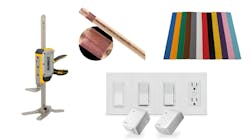Networked Lighting Controls (NLCs) are effective energy-savers for commercial buildings, with potential to increase the efficiency of LED lighting projects by an average of almost 50 percent and much more if they’re linked with HVAC systems. This potential remains largely untapped, however, since NLCs still only comprise an estimated five to ten percent of installed commercial lighting in the U.S. A noteworthy factor preventing broader adoption is unfamiliarity with the technology and how to use its features to the best advantage.
The DesignLights Consortium (DLC) views NLCs as the key to not only unlocking significantly more energy savings from LED lighting projects but future-proofing them as well. In addition to its Qualified Products List (QPL) for LEDs (the largest verified list of high-performing commercial lighting products in the world), the DLC maintains a QPL of 72 independently vetted NLC systems from over 40 manufacturers. The DLC also provides other resources on its website to help project designers, installers and others navigate this growing NLC landscape for optimal outcomes.
“Lighting Controls Best Practices” is a handy reference just published this month (June 2024). In it, you will find easy-to-understand descriptions of five basic lighting control strategies required by most commercial and industrial NLC incentive programs, as well as tips on how to deploy these strategies on projects with confidence.
Proven to save energy and help provide appropriate light when and where it’s needed, the strategies covered include:
- Dimming – a foundational strategy that’s easy to implement and enables several other energy saving lighting control strategies
- High End Trim (aka Task Tuning) – the process of setting maximum light levels lower than the maximum fixture output, without end-users noticing
- Occupancy/Vacancy Sensing – a process that uses a variety of devices to detect human presence and turn lights off when people aren’t around
- Scheduling – the process of turning lights on and off according to predetermined times, which can overcome challenges with other strategies such as falsely triggered occupancy sensors
- Daylight Harvesting – the process of lowering electric lighting levels in response to available natural light from windows and/or skylights while maintaining a steady minimum light level
While understanding all the possible functions of an NLC system is a necessary step, it’s also important to make sure lighting control systems are properly configured so they perform as intended. The DLC’s online tutorial, “NLC System Configuration Considerations”, outlines five key aspects to think through:
- Method – What steps must be taken to configure the system you’re using? Does the system have specific configuration requirements and procedures?
- Means – What will you need to configure the system? Does it require something as simple as an app, or will it entail downloading software to a laptop or using a dedicated control system on site?
- Responsibility – Who is responsible for configuration? Will the system be configured by an installer with minimal training, or require a third-party factory trained professional or configuration by the manufacturer on site?
- Maintenance – How will ongoing maintenance be handled? Is this provided in the manufacturer’s original service agreement, or will it be done through adequate customer training or through a separate service contract?
- Reporting – How will the system’s energy use and performance data be reported (if required)?
In addition to the resources above, the DLC’s website provides free access to a searchable and sortable NLC QPL to facilitate selection of a system that fits individual configuration needs and preferences. To get started, just create a MyDLC account, log on and go to Find Products. With this information at our fingertips, we can work on realizing the huge potential savings from networked lighting controls and reducing unnecessary energy consumption.




